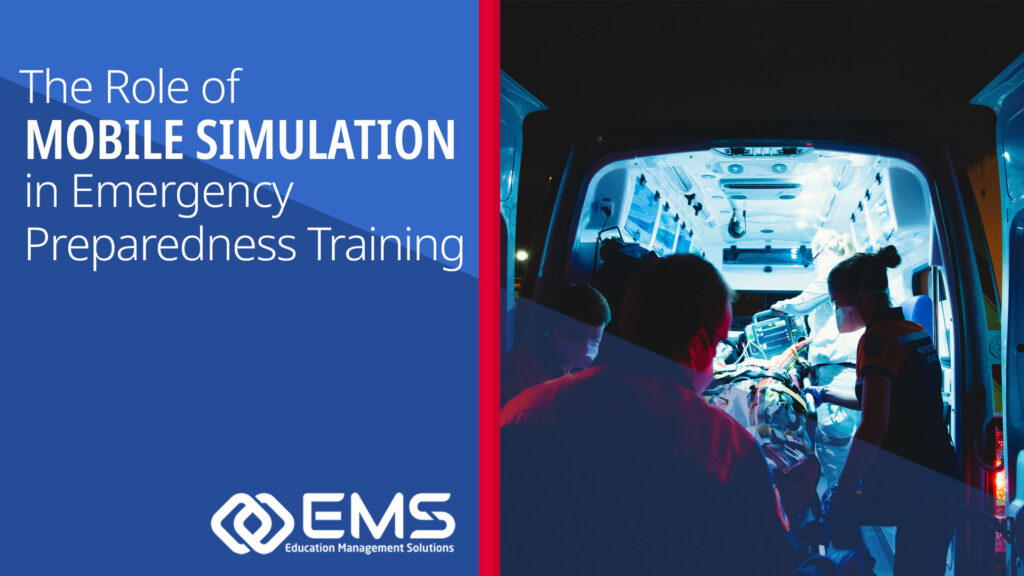Emergency preparedness is an important aspect of healthcare training, enabling institutions to respond swiftly and efficiently to crises. But preparing for such quick-moving and chaotic situations in real-life environments can be challenging. Enter mobile healthcare simulation technology. Mobile sim is emerging as an innovative solution to enhance the realism and effectiveness of emergency preparedness training from in-hospital emergency care to disaster preparedness and military applications. Mobile simulation’s versatility is revolutionizing how future healthcare practitioners prepare for emergencies.
In this blog post, we will explore the real-world applications of mobile simulation across various sectors, examine its benefits in preparing for emergencies, and look to the future of its implementation.
Enhancing In-Hospital Emergency Care
The best hospital systems are in a constant state of preparation for a myriad of emergencies, including cardiac arrests, trauma cases, and large-scale medical crises. Mobile simulation brings several advantages to this kind of in-hospital emergency care training.
Because of their small size and ease-of-use, mobile simulation units can be deployed directly within hospital settings, offering realistic training scenarios that mimic actual patient conditions. This allows instructors to conduct in-situ drills that help refine teamwork and communication, crucial in real-life emergencies.
Revolutionizing Out-of-Hospital Care
Out-of-hospital care, including ambulance services and emergency medical response teams, demands quick decision-making under pressure. Mobile simulation helps prepare these teams effectively because it allows simulations to easily be set up in ambulances or field locations, providing realistic training in pre-hospital settings.
Paramedics trained through mobile simulation can demonstrate improved on-scene patient management and quicker stabilization, which can lead to better survival rates.
Strengthening Disaster Preparedness
Disaster scenarios require a coordinated response from multiple agencies and disciplines. Mobile simulation can play a crucial role in preparing for such large-scale emergencies by focusing on the integration and debriefing of various emergency response teams, including healthcare providers, fire departments, and law enforcement.
These comprehensive disaster preparedness drills enhance interagency communication and provide participants with hands-on experience in managing disaster scenarios. The result is a more cohesive and effective response during actual events.
Advancing Military Medical Training
Military medical personnel often face extreme conditions and must be ready to provide care in diverse environments. Mobile simulation is a vital tool in their instructional arsenal by supporting realistic battlefield medical training.
Mobile simulation is used extensively to prepare battlefield medics for combat scenarios, including battlefield trauma and mass casualty events increasing readiness and improved outcomes for warfighters needing medical interventions in conflict zones.
Key Benefits of Mobile Simulation in Emergency Preparedness
- Realism and Hands-On Experience
Because mobile simulation technology can be deployed almost anywhere, the ability to create highly realistic training environments allows trainees to practice hands-on skills in scenarios that closely mimic real-life emergencies. This increased realism lends itself to future practitioners more seamlessly transferring learned skills during simulations into real-world practice.
- Scalability and Flexibility
Mobile simulation solutions are scalable and can be adapted to various settings, from small clinics to large hospitals or field locations. And because of their modular quality, these solutions agilely support ongoing professional development and can be seamlessly incorporated into existing training programs.
- Cost-Effectiveness and Efficiency
Mobile simulation can offer significant cost advantages compared to traditional simulation labs, which often require a more intensive investment and are largely stationary. Because mobile simulation units require less hardware costs up front, they can be deployed as a training program sees fit, growing and expanding when needed.
Mobile Simulation: A Vital Component of Emergency Preparedness Training
Mobile simulation technology is transforming emergency preparedness training by providing realistic, hands-on experiences that traditional methods often lack. From in-hospital and out-of-hospital care to disaster preparedness and military applications, mobile simulation is equipping healthcare professionals with the skills and confidence needed to handle emergencies effectively. Embracing mobile simulation can lead to better preparedness, improved patient outcomes, and a more robust emergency response system.
To find out how Education Management Solutions can support your simulation training program with our premier mobile solutions, schedule a discussion today.

